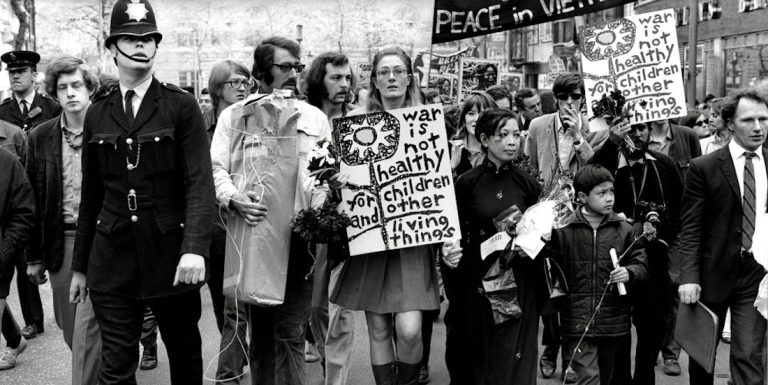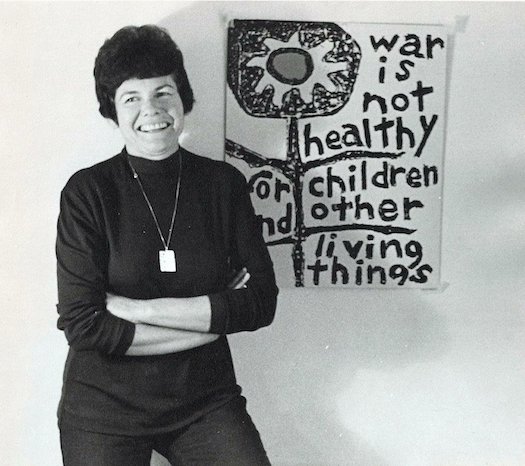
In 1967, a group of California mothers transformed maternal concern into a global movement, championing nonviolence through iconic art and tireless advocacy that still resonates today.
New York, N.Y.—In the turbulent spring of 1967, as the Vietnam War escalated and televised images of violence haunted American living rooms, a small group of mothers in Los Angeles gathered around kitchen tables.
Their frustration over the conflict’s impact on children crystallized into a bold mission: to harness maternal authority as a moral force for peace. Thus began Another Mother for Peace (AMP), a grassroots collective whose legacy endures through its unforgettable slogan—War is not healthy for children and other living things—and its unflinching advocacy for a gentler world.

The Spark That Ignited a Movement
Founded by advertising copywriter Barbara Avedon and artist Lorraine Schneider, AMP blended artistic ingenuity with strategic activism. Avedon’s rallying cry—“We’ll use the only strength we have: the power of consumers, voters, and mothers”—became their operational blueprint. They organized telephone trees, lobbied Congress, and distributed educational pamphlets.
But it was Schneider’s minimalist 1967 poster, featuring a sunflower and their signature message, that catapulted AMP into popular consciousness. Printed for just $50, the design was deliberately royalty-free, enabling global replication. By 1969, over half a million copies adorned homes, schools, and protest marches worldwide.

Art as a Weapon Against War
Schneider’s sunflower poster became the Anti-War Movement’s most recognizable visual anthem, subverting traditional motherhood tropes to challenge militarism.
The image’s simplicity—a childlike flower beside stark black text—contrasted sharply with government propaganda.
AMP leveraged this cultural momentum, launching campaigns like “Give a Damn.”
This urged mothers to withhold holiday shopping funds until troop withdrawals began.
Their 1970 Mother’s Day card to politicians bluntly asked: “How many more mothers must weep?”
Such tactics spotlighted war’s human cost, shifting public discourse toward intergenerational accountability.
Beyond Vietnam: Evolving the Mission
When the Vietnam War ended, AMP refused complacency. Recognizing that “peace is more than the absence of war,” they expanded into Nuclear Disarmament advocacy and environmental justice.
In the 1980s, they collaborated with Physicians for Social Responsibility to expose nuclear testing’s health risks, mailing thousands of radiation-detection postcards to lawmakers. Later, they championed landmine bans and refugee rights. Executive Director Julie Levine notes: “Our founders understood that protecting children requires confronting all forms of violence—structural, environmental, or militarized.”
A Living Legacy for New Generations

Today, AMP’s sunflower still blooms digitally. Their Peace Portal educates students on conflict resolution, while social media campaigns like #MothersAgainstArms pressure policymakers to end weapons proliferation.
Youth engagement remains central; their 2023 “Plant Peace” initiative funded urban gardens in conflict zones. For historian Dr. Elena Rodriguez, AMP’s endurance stems from its universality: “They framed peace as a practical, nurturing act—not political idealism. That speaks across decades.”
Why Their Message Still Matters
In an era of climate crises and regional wars, AMP’s ethos—that caregiving confers moral authority—feels urgently relevant.
Modern iterations include Mothers of the Movement advocating against gun violence and Ukrainian mothers evacuating children under shellfire. As AMP’s current director Maya Chen asserts: “When mothers lead with empathy, they model the world we deserve: one where no child is collateral damage.”
Audio Summary (75 words)
Founded in 1967, Another Mother for Peace transformed maternal concern into global advocacy. Their iconic “War is not healthy” poster became an anti-war symbol. Beyond Vietnam, they championed nuclear disarmament and refugee rights. Today, they empower youth through digital peace education and environmental projects. Their legacy proves that compassion, amplified by collective action, can challenge violence across generations. Discover how their mission continues to inspire modern activism.